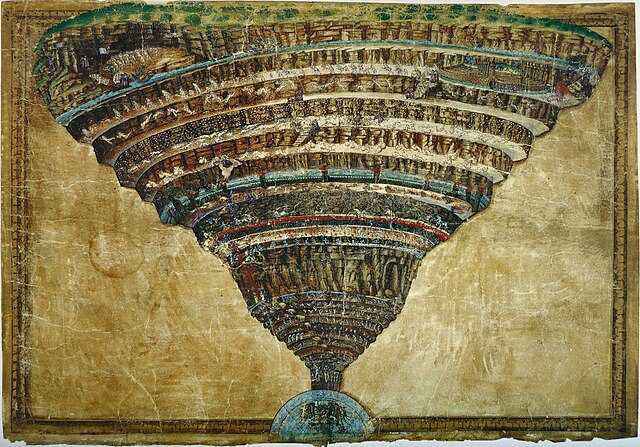
Name: Chart of Hell
Artist: Sandro Botticelli
Date Painted: 1495
Period: Renaissance
Dimensions: 32.5cm (h) x 47.5 cm (w)
Medium / Material: Pen and Ink on Sheep Parchment
Current Location: The Vatican Libraries
Introduction
Sandro Botticelli’s “Map of Hell” is a fascinating work that intricately visualizes Dante Alighieri’s “Inferno,” the first part of his epic poem “The Divine Comedy.” This artwork, also known as the “Abyss of Hell” or “La Mappa dell’Inferno,” was created in the early 1480s and is believed to have been commissioned by Lorenzo di Pierfrancesco de’ Medici, a member of the powerful Medici family and a patron of Botticelli. The map serves as a detailed illustration of Hell as described by Dante, showcasing the various circles and regions of Hell along with the sinners and their punishments.
Structure of Hell
Botticelli’s map depicts Hell as a series of concentric circles, each representing a different sin with corresponding punishments, as laid out by Dante. Hell is imagined as a huge funnel that extends all the way to the center of the Earth, with Lucifer trapped at the very bottom. The structure reflects medieval Christian theology and cosmology, incorporating aspects of both moral judgment and the physical layout of the universe.
Artistic Interpretation
The work is notable for its attention to detail and the vividness of its imagery. Botticelli meticulously illustrates the various sinners and their torments, providing a visual counterpart to Dante’s descriptions. His use of line and composition guides the viewer’s eye through the complex landscape of Hell, highlighting the poet Dante and his guide Virgil’s journey through the abyss.
Botticelli’s interpretation of Hell is not just a literal depiction of Dante’s text but also an artistic exploration of its themes. Through the use of visual symbolism and creative flourishes, Botticelli conveys the emotional and moral depth of Dante’s work, emphasizing the consequences of human actions and the nature of divine justice.
Significance
The “Map of Hell” is significant not only for its artistic achievement but also for its cultural and historical context. It represents a synthesis of Renaissance humanism and medieval Christian theology, reflecting the era’s intellectual currents and Botticelli’s own interests and beliefs. The work illustrates the continued relevance of Dante’s poem during the Renaissance and its impact on the visual arts.
Furthermore, the map provides insight into the medieval and Renaissance imagination, revealing how artists and thinkers of the time visualized abstract concepts and narratives. It stands as a testament to the enduring power of Dante’s “Inferno” to inspire artists and captivate audiences through the centuries.
Conclusion
Botticelli’s “Map of Hell” is a masterful representation of Dante’s “Inferno,” offering a unique window into the visual and cultural landscape of the Renaissance. Through its detailed portrayal of Hell’s structure, inhabitants, and punishments, the artwork invites viewers to reflect on the themes of sin, redemption, and divine justice. As a piece of both art and literature, it remains a powerful interpretation of one of the great works of Western civilization.